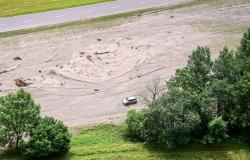(Washington) Last year, catastrophic wildfires fueled by global warming in Canada released more heat-trapping carbon dioxide into the air than India did by burning fossil fuels, setting fire to an area of forest larger than West Virginia, a new study finds.
Posted at 8:37 a.m.
Seth Borenstein
Associated Press
Scientists from the World Resources Institute and the University of Maryland have calculated the devastating impact of the fires that raged for months in Canada in 2023 and polluted the air across much of the globe.
Those fires released 2.98 billion metric tons of heat-trapping carbon dioxide into the air, according to an updated study published Thursday in the journal Global Change Biology. This update has not been peer-reviewed, unlike the original study.
According to the study authors, the fire released almost four times more carbon emissions than airplanes in one year. That’s about the same amount of carbon dioxide that 647 million cars emit into the air in a year, according to data from the U.S. Environmental Protection Agency.
Forests “remove a lot of carbon from the atmosphere, and it’s stored in their branches, trunks, leaves, and in the soil. So when they burn, all that carbon that’s stored there is released back into the atmosphere,” said the study’s lead author, James MacCarthy, a research associate with WRI’s Global Forest Observatory.
If trees grow back, much of that carbon can be captured, MacCarthy said, adding that “it certainly has an impact globally in terms of the amount of emissions produced in 2023.”
MacCarthy and his colleagues calculated that burned forests totaled 77,574 square kilometers, six times more than the average recorded between 2001 and 2022. Wildfires in Canada accounted for 27% of forest cover loss global growth last year, whereas usually this figure is closer to 6%, according to Mr. MacCarthy’s figures.
These fires are much larger than typical wildfires, but the researchers focused only on the loss of tree cover, which has a greater effect, said Alexandra Tyukavina, co-author of the study and professor of geography at the University of Maryland.
“The loss of this amount of forest is very significant and very concerning,” said Jacob Bendix, professor of geography and environment at Syracuse University, who was not involved in the study.
“Although the forest will eventually regrow and sequester carbon, this process will take decades at a minimum, so there is a fairly large lag between the addition of atmospheric carbon from wildfires and the eventual removal of carbon. at least part of this carbon comes from the regrowing forest. Thus, over these decades, the net impact of fires is a contribution to global warming. »
It is not just an increase in heat-trapping gases and the disappearance of forests, there are also health consequences, recalled Ms.me Tyukavina.
“Due to these catastrophic fires, air quality in populated areas and cities was affected last year,” she said, mentioning New York’s smog-ridden summer. More than 200 communities with about 232,000 residents had to be evacuated, according to another study by Canadian forest and fire experts that has not yet been published or peer-reviewed.
One of the authors of the Canadian study, Mike Flannigan, a fire expert at Thompson Rivers University in Kamloops, British Columbia, estimates that the area burned is twice that calculated by Mr. MacCarthy and Mr.me Tyukavina.
“The 2023 fire season in Canada was an exceptional year for any period,” Flannigan, who was not involved in the WRI study, said in an email. I expect there will be more fires in the future, but years like 2023 will be rare. »
M. Flannigan, M. Bendix, Mme Tyukavina and MacCarthy all agree that climate change played a role in the Great Fire of Canada.
A warmer world means a longer fire season, more fires caused by lightning, and especially drier wood and brush igniting “as a result of rising temperatures,” Flannigan wrote . Last year, the average temperature from May to October in Canada was almost 2.2 degrees Celsius higher than normal, according to Mr. Flannigan’s study. Some regions of Canada experienced temperatures 8 to 10 degrees Celsius above average in May and June, MaCarthy said.
There is short-term variability in trends, so it is difficult to attribute climate change to a specific year and area burned, and geographic factors play a role, but “there is no doubt that change Climate change is the main driver of the global increase in wildfires,” Bendix warned in an email.
“With global warming due to climate change, catastrophic years are likely to occur more often and we are going to see these more severe years more often,” warned Mme Tyukavina.







